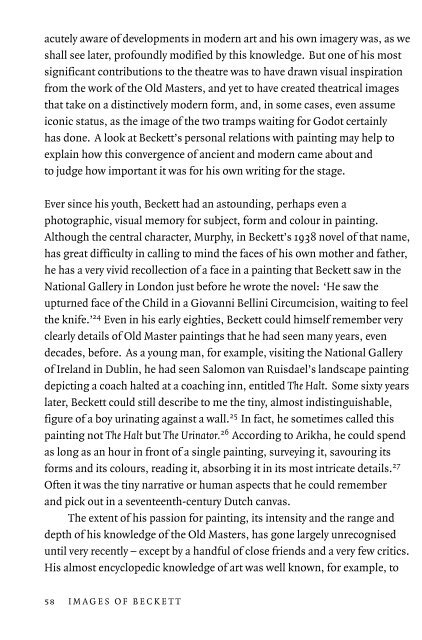You also want an ePaper? Increase the reach of your titles
YUMPU automatically turns print PDFs into web optimized ePapers that Google loves.
acutely aware <strong>of</strong> developments in modern art and his own imagery was, as we<br />
shall see later, pr<strong>of</strong>oundly modified by this knowledge. But one <strong>of</strong> his most<br />
significant contributions to the theatre was to have drawn visual inspiration<br />
from the work <strong>of</strong> the Old Masters, and yet to have created theatrical images<br />
that take on a distinctively modern form, and, in some cases, even assume<br />
iconic status, as the image <strong>of</strong> the two tramps waiting for Godot certainly<br />
has done. A look at <strong>Beckett</strong>’s personal relations with painting may help to<br />
explain how this convergence <strong>of</strong> ancient and modern came about and<br />
to judge how important it was for his own writing for the stage.<br />
Ever since his youth, <strong>Beckett</strong> had an astounding, perhaps even a<br />
photographic, visual memory for subject, form and colour in painting.<br />
Although the central character, Murphy, in <strong>Beckett</strong>’s 1938 novel <strong>of</strong> that name,<br />
has great difficulty in calling to mind the faces <strong>of</strong> his own mother and father,<br />
he has a very vivid recollection <strong>of</strong> a face in a painting that <strong>Beckett</strong> saw in the<br />
National Gallery in London just before he wrote the novel: ‘He saw the<br />
upturned face <strong>of</strong> the Child in a Giovanni Bellini Circumcision, waiting to feel<br />
the knife.’ 24 Even in his early eighties, <strong>Beckett</strong> could himself remember very<br />
clearly details <strong>of</strong> Old Master paintings that he had seen many years, even<br />
decades, before. As a young man, for example, visiting the National Gallery<br />
<strong>of</strong> Ireland in Dublin, he had seen Salomon van Ruisdael’s landscape painting<br />
depicting a coach halted at a coaching inn, entitled The Halt. Some sixty years<br />
later, <strong>Beckett</strong> could still describe to me the tiny, almost indistinguishable,<br />
figure <strong>of</strong> a boy urinating against a wall. 25 In fact, he sometimes called this<br />
painting not The Halt but The Urinator. 26 According to Arikha, he could spend<br />
as long as an hour in front <strong>of</strong> a single painting, surveying it, savouring its<br />
forms and its colours, reading it, absorbing it in its most intricate details. 27<br />
Often it was the tiny narrative or human aspects that he could remember<br />
and pick out in a seventeenth-century Dutch canvas.<br />
The extent <strong>of</strong> his passion for painting, its intensity and the range and<br />
depth <strong>of</strong> his knowledge <strong>of</strong> the Old Masters, has gone largely unrecognised<br />
until very recently – except by a handful <strong>of</strong> close friends and a very few critics.<br />
His almost encyclopedic knowledge <strong>of</strong> art was well known, for example, to<br />
58 IMAGES OF BECKETT<br />
his friend and later director <strong>of</strong> the National Gallery <strong>of</strong> Ireland, Thomas<br />
MacGreevy, with whom <strong>Beckett</strong> corresponded at length in the 1930s,<br />
frequently about painting. But their correspondence has not been readily<br />
available and, as I write, it can be read only on micr<strong>of</strong>ilm in Trinity College,<br />
Dublin. Over the years, <strong>Beckett</strong> sent literally hundreds <strong>of</strong> reproductions,<br />
mostly <strong>of</strong> Old Master paintings, to his friends, from postcards to poster-size<br />
reproductions, and in turn received them back; as a priority, he visited art<br />
galleries and churches that held important paintings, in whichever large<br />
town or city he found himself, both before and after the Second World War;<br />
he bought dozens <strong>of</strong> catalogues <strong>of</strong> art collections, many <strong>of</strong> which still exist<br />
today, handed on by <strong>Beckett</strong> to Arikha; and he acquired numerous books on<br />
painting. As faithful as the most assiduous lover, he went back to see<br />
particular paintings that he admired, even adored, time after time after time.<br />
In the 1930s he swapped ideas on their attributions with MacGreevy,<br />
doubting sometimes what the curators and the <strong>of</strong>ficial catalogues said about<br />
the artist. And he discussed specific details <strong>of</strong> paintings: a hand, a foot, a<br />
colour, the state <strong>of</strong> preservation <strong>of</strong> a canvas, or the restoration work that had<br />
been done or that needed doing. He had an excellent eye. The line <strong>of</strong> the left<br />
leg <strong>of</strong> a figure in a Giorgione painting is wrong, he suggested to MacGreevy –<br />
and the experts concluded that the leg had indeed been painted over in the<br />
nineteenth century. 28<br />
<strong>Beckett</strong>’s ability to draw parallels and to make fascinating comparisons<br />
was astounding. In 1937 he compared, for instance, the shepherd in a<br />
Signorelli painting in the Kaiser Wilhelm Friedrich Museum in Berlin with an<br />
El Greco that he had last seen in London two years before. 29 His confidence<br />
in his own aesthetic judgement was (to me at least) breathtaking. His best<br />
and most realistic idea for gainful employment in the 1930s, when writing<br />
was bringing him in almost no income at all, was to apply for the post <strong>of</strong><br />
assistant curator at London’s National Gallery.<br />
We can discern a number <strong>of</strong> important stages in <strong>Beckett</strong>’s artistic<br />
Odyssey. He seems to have fallen in love with painting first while he was a<br />
student at Trinity College, Dublin, in the early 1920s, although his interest<br />
may already have been nurtured by his aunt, Cissie Sinclair, who was herself a


